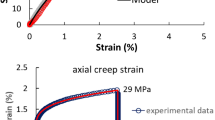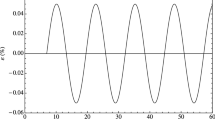Abstract
Fractional order models of viscoelasticity have proven to be very useful for modeling of polymers. Time domain responses as stress relaxation and creep as well as frequency domain responses are well represented. The drawback of fractional order models is that the fractional order operators are difficult to handle numerically. This is in particular true for fractional derivative operators. Here we propose a formulation based on internal variables of stress kind. The corresponding rate equations then involves a fractional integral which means that they can be identified as Volterra integral equations of the second kind. The kernel of a fractional integral is integrable and positive definite. By using this, we show that a unique solution exists to the rate equation. A motivation for using fractional operators in viscoelasticity is that a whole spectrum of damping mechanisms can be included in a single internal variable. This is further motivated here. By a suitable choice of material parameters for the classical viscoelastic model, we observe both numerically and analytically that the classical model with a large number of internal variables (each representing a specific damping mechanism) converges to the fractional order model with a single internal variable. Finally, we show that the fractional order viscoelastic model satisfies the Clausius–Duhem inequality (CDI).
Similar content being viewed by others
References
Adolfsson, K. and Enelund, M., ‘Fractional derivative viscoelasticity at large deformations’, Nonlinear Dyn. 33, 2003, 301–321.
Adolfsson, K., Enelund, M. and Larsson, S., ‘Adaptive discretization of fractional order viscoelasticity using sparse time history’, Comput. Methods Appl. Mech. Eng. 193, 2004, 4567–4590.
Bagley, R.L. and Torvik, P.J., ‘Fractional calculus –A different approach to the analysis of viscoelastically damped structures’, AIAA J. 21, 1983, 741–748.
Bagley, R.L. and Torvik, P.J., ‘On the fractional calculus model of viscoelastic behavior’, J. Rheol. 30, 1986, 133–155.
Bateman, H., Higher Transcendental Functions, Vol. III, McGraw-Hill, New York, 1955.
Boltzmann, L., ‘Zur theorie der elastichen nachwirkung’, Annalen der physik und chemie 77, 1876, 624–654.
Caputo, M. and Mainardi, F., ‘A new dissipation model based on memory mechanism’, Pure Appl. Geophys. 91, 1971, 134–147.
Christensen, R.M., Theory of Viscoelasticity: An Introduction, Academic Press, New York, 1971.
Enelund, M. and Lesieutre, G.A., ‘Time domain modeling of damping using anelastic displacement fields and fractional calculus’, Int. J. Solids Struc. 36, 1999, 4447–4472.
Enelund, M. and Olsson, P., ‘Damping described by fading memory –Analysis and application to fractional derivative models’, Int. J. Solids Struc. 36, 1999, 939–970.
Enelund, M., Mähler, L., Runesson, K. and Josefson, B.L., ‘Formulation and integration of the standard linear viscoelastic solid with fractional order rate laws’, Int. J. Solids Struc., 36, 1999, 2417–2442.
Fung, Y.C., Foundations of Solid Mechanics, Prentice-Hall, New Jersey, 1965.
Gel’fand, I.M. and Shilov, G.E., Generalized Functions: Vol. I. Properties and Operations, Academic Press, San Diego, LA, 1964.
Koeller, R.C., ‘Applications of fractional calculus to the theory of viscoelasticity’, ASME J. Appl. Mech. 51, 1984, 299–307.
Lion, A., ‘On the thermodynamics of fractional damping elements’, Continuum Mech. Thermodyn. 9, 1997, 83–96.
Lubich, C., ‘Discretized fractional calculus’, SIAM J. Math. Anal., 17, 1986, 704–719.
Oldham, K.B. and Spanier, J., The Fractional Calculus, Academic Press, New York, 1974.
Rabotnov, Yu.N., Elements of Hereditary Solid Mechanics, Mir Publishers, Moscow, 1980.
Rossikhin, Y.A. and Shitikova, M.V., ‘Applications of fractional calculus to dynamic problems of linear and nonlinear hereditary mechanics of solids’, Appl. Mech. Rev. 50, 1997, 15–67.
Reed, M. and Simon, B., Methods of Modern Mathematical Physics, Vol. II, Academic Press, New York, 1975.
Schmidt, A. and Gaul, L., ‘Finite element formulation of viscoelastic constitutive equations using fractional time derivatives’, Nonlinear Dyn. 29, 2002, 37–55.
Welch, S.W.J., Rorrer, R.A.L. and Duren, R.G., Jr., ‘Application of time-based fractional calculus methods to viscoelastic creep and stress relaxation of materials’, Mech. Time Depend. Mater. 3, 1999, 279–303.
Author information
Authors and Affiliations
Corresponding author
Rights and permissions
About this article
Cite this article
Adolfsson, K., Enelund, M. & Olsson, P. On the Fractional Order Model of Viscoelasticity. Mech Time-Depend Mater 9, 15–34 (2005). https://doi.org/10.1007/s11043-005-3442-1
Received:
Revised:
Issue Date:
DOI: https://doi.org/10.1007/s11043-005-3442-1




